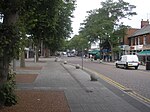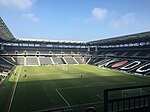Stadium MK is a football ground in the Denbigh district of Bletchley in Milton Keynes, Buckinghamshire, England. Designed by Populous and opened in 2007, it is the home ground of EFL League Two side Milton Keynes Dons and FA Women's National League South side Milton Keynes Dons Women. In 2022, the stadium hosted several matches during the UEFA Women's Euro 2022.
As of May 2015, the stadium has two tiers which hold a capacity of 30,500. Should it be required, there is the option to increase the capacity of the stadium again to 45,000 with the addition of a third tier, hence the high roof. The design meets UEFA's Elite Stadium specifications and includes a Desso GrassMaster playing surface.
The plans of the complex included an indoor arena, Arena MK (now known as The Marshall Arena), that was to be the home of the Milton Keynes Lions professional basketball team. However, the retail developments that would have provided enabling funding were deferred due to lack of financing, leaving the Lions without a home. Following the conclusion of the 2011–12 season, the Lions could not secure a venue within Milton Keynes, resulting in their relocation to London.In addition to association football, the stadium occasionally hosts rugby union. The first such occasion was in May 2008, when Saracens (who at the time groundshared with Watford at Vicarage Road) played Bristol at Stadium MK because Watford needed their ground for a Championship play-off. In 2011, Northampton Saints RFC used the ground for their Heineken Cup quarter and semi-final matches because their home ground is too small for major events. The stadium hosted three matches in the 2015 Rugby World Cup.The stadium also hosts music concerts, with artists including Take That, Rammstein, Rod Stewart, Olly Murs, My Chemical Romance and Imagine Dragons having performed there in recent years.








